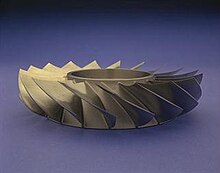Blisk
The word blisk is an English short form for "Blade Integrated Disk", also called "integrally bladed rotor" (IBR), which is made up of the words blade and disk . It describes a component that is used in engine and turbine construction . By replacing up to 120 individual blades per disk with a blisk, there are no assembly costs. Furthermore, a considerable weight saving is achieved with this method, which is of great interest especially in the field of aviation. In particular, less stressed components can be replaced by blisks.
Only computer-controlled cutting machines can produce blisks. The basis of a blisk is a forged disc, from whose outer contour the blade profiles are machined. Another possible manufacturing process is the attachment of the blade profiles by friction welding . The disks on the compressor side are usually made of titanium, while the engine disks on the turbine side are usually made of a surface-hardened nickel-based alloy .
In contrast to replacing individual blades, replacing a blisk is very complex and expensive. For this reason, worn blisks are increasingly being repaired using metal deposition methods such as laser deposition welding . Another method of repairing blisks is friction welding . Here a damaged or worn blade is separated from the blisk and replaced by a new blade by means of friction welding.
The idea of the blisk was first introduced when the Eurofighter jet engine EJ200 was designed in 1995.
Blisks made from composite materials are also used in newer aircraft engines .
Web links
- Article about blisks on the website of the Society of Automotive Engineers (SAE), accessed on November 12, 2010 (English)
Individual evidence
- ↑ Dennis Dilba: How shovels and discs were found. In: AEROREPORT - the aviation magazine from MTU Aero Engines. MTU Aero Engines, January 1, 2019, pp. 17–19 , accessed on March 26, 2020 .
